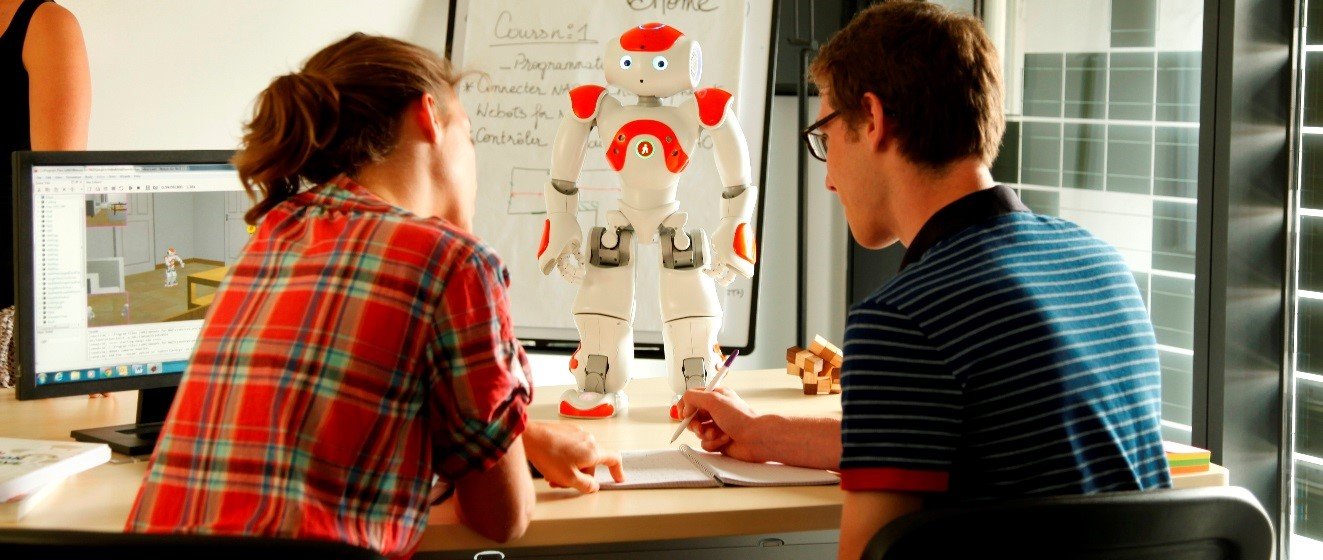Important Role of Robots in Educating People
Robots in classrooms are no longer an unimaginable vision. They are being used in various schools from different parts of the world for education purposes. Humanoid robots are being used these days in teaching Science, Technology, Engineering, and Math or the STEM subjects to children especially to places that are having problems with these subjects. This is why NAO robots are distributed to many organizations in order to improve standard education.

- 1 Comments
- Oct 15, 2015 12:52:17 AM
- Posted by Kate Morgan
- Topics: Robotics, Teaching with the RobotsLAB BOX, STEM, NAO
Robots in Pre-Calculus

As part of a school wide implementation of Problem based Learning (PBL), the pre-calculus classes at Sammamish High school in Bellevue, WA used robots to teach math. The prompt was simple, “What pre-calculus level math lesson could you teach using one of the robots we have?” The work produced was amazing!
First the students were given the opportunity to play with the robots and see how they worked. They had access to all four of the robots from the RobotsLAB kit: Sphero – a small robotic ball, ArmBot – a mechanical arm that can pick objects up, Mobot – a rover that moves with precision, and a quadcopter AR.Drone. Students also had access to an additional robot, LinkBot – two rover bots who could be programmed to mimic each other. After students investigated each robot, they selected one robot to use as a tool to teach a pre-calculus level lesson. Students had the option of choosing a topic they had already studied or choosing a topic they had yet to study.
- 0 Comments
- Apr 21, 2014 10:00:00 AM
5 Tools Everyone In The Educational Robotics Industry Should Be Using
Of course the first answer to the question posited by the title of this piece is a facetious one--lots of money! So let us qualify the question a bit more by asking, "What are 5 tools everyone in the educational robotics industry should be using that most of us in the industry can afford?"
Since learning to code is so important to any STEM discipline, the first tool everyone in the educational robotics industry should be using is the online community and programming language called Scratch. This innovative site helps kids learn its namesake programming language and create interactive stories, games and computer animations. This outstanding tool is actually free!
Since math is basic to any scientific endeavor, the ability to interest and engage students in math is crucial to the educational robotics industry. Our second tool that everyone in the industry should be using, the RobotsLAB BOX, has proved its ability to interest and engage kids in math with an innovative combination of robots and tablets in many progressive school districts. The old teaching standbys like the book and the whiteboard can’t compete with "cool" robot helicopters demonstrating quadratic equations in real-time on a tablet.
- 0 Comments
- Jan 24, 2014 12:00:00 PM
- Posted by Elad Inbar
- Topics: Math, Robotics, Teaching with the RobotsLAB BOX, About the BOX, EdTech, STEM, Education, Computer Science, NAO, code, 21st Century Classroom, School, Student Engagement, Middle School
How To Solve The Biggest Problem With STEM Education
Judging from the number of e-gadget users in this country, technology is all the rage. Over 90% of adults have a cell phone. Thirty-four percent (34%) own a tablet. And no one doubts that the percentages will continue to rise. One might also be forgiven for thinking our schools are up to the job of graduating the vast numbers of science, technology, engineering and math students needed to keep this country in the forefront of this technology wave--the interest is obviously there. Unfortunately that is not the case!
By 2018--now less than 4 years and a single generation of high school students away--we are expecting at least 8 million jobs in the US dependent on skills learned in STEM learning courses. But experts estimate that less than five million of those jobs will go to kids from American schools, with three million or more of these well-paid positions going to foreign applicants.
Why is this happening? Why can’t our schools keep up with the demand for young people trained in science, technology, engineering and math? Well as you might expect there are all sorts of excuses for this, from lack of funding to a lack of interest in STEM learning on the part of students themselves. We at RobotsLAB can’t do much about the funding issue; that requires political action. What we can do is help change the culture of math education.
- 0 Comments
- Jan 23, 2014 10:00:00 AM
- Posted by Mike Nardine
- Topics: Math, Teaching with the RobotsLAB BOX, About the BOX, EdTech, STEM, Education, 21st Century Classroom, Student Engagement, Middle School
Relevant Posts
Popular Posts
Subscribe to Email Updates
-
I Want To Learn MoreADDITIONAL INFORMATION


